Term 2 Chapter 3 | 5th Science - Plants | 5th Science : Term 2 Unit 3 : Plants
Chapter: 5th Science : Term 2 Unit 3 : Plants
Plants
UNIT 3
Plants

Learning Objectives
After completing this lesson, students
will be able to
* know about types of pollination and
the agents of pollination.
* understand the life cycle of flowering
plants.
* identify different types of soil.
* know how the honey bee, earthworm,
dragon fly are useful to farmers.
Introduction
Plants are useful to us in a number of
ways. Plants produce their own food. At the same time they are used as food by
men and animals. Plants are not only used as food but also as medicine. Almost
all parts of the plants are useful to us. As a natural resource they are
beautiful and pleasing to our eyes. They release oxygen, which is essential for
our survival, into the atmosphere. Some plants grow in our surrounding
naturally and some are grown by us. We need to know about plants which are
useful to us in many ways. Let us study in this lesson about the life cycle of
plants, agriculture and the types of soil.
I. Reproduction in Plants
Reproduction is the process by which new
individuals of the same species are produced. Both plants and animals
reproduce. The flowers perform the function of
reproduction in plants. There are two kinds of reproduction that take place in
plants. They are sexual reproduction and asexual reproduction. In asexual
reproduction, new plants are produced from roots, leaves, stems and buds. In
sexual reproduction, new plants emerge from seeds.
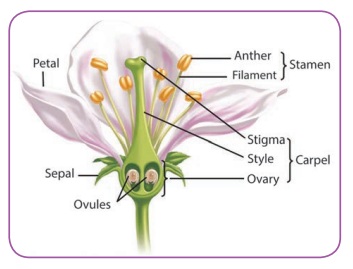
1. Flower
Flower is the reproductive part of a
plant. It is a modified shoot. Flowers have four important parts. They are:
* Sepal
* Petal
* Androecium
* Gynoecium
* Sepal
It is the outer part of the flower. Usually
it is small and green in colour. It protects the bud in the early stage.
* Petal
It is often colourful and it attracts
the insects.
* Androecium
It is the male reproductive part of the
flower. It is composed of stamens. Each stamen consists of a stalk called
filament and a small bag like structure called anther at the tip. The pollen
grains are produced in the anther within the pollen sacs.
*Gynoecium
It is a female part of the flower. It
has three parts. They are: ovary, style and stigma. The ovary contains the
ovules.
The flowers which contain either
androecium or gynoecium are called unisexual
flowers. E.g. Corn, Papaya, Cucumber. The flowers which contain both
androecium and gynoecium are called bisexual
flowers. E.g. Mustard, Rose.

To attract the pollinators (E.g.
Insects) plants are bright in colour and produce smell in their flowers. Plants
which are pollinated by the honey bees and butterflies have sweet scents and
bigger colourful petals. E.g. Sunflower, Pumpkin. Pigments present in petals
give them different colours. Plants which are pollinated by the moth and bats
release their fragrance mostly at night and have colourless petals. E.g. Mango,
Banana, Guava, Jasmine etc. The following table gives the names of the pigment
present in petals.

Activity 1
Take a hibiscus flower or
a rose flower. Display the parts like sepal, petal, gynoecium and androecium in
a chart paper and note down its colour and shape.
Do you know?
Kurinji or Neelakurinji
(Strobilanthes kunthianu) is a shrub that is found in the Chola forests of the
Western Ghats in South India. Nilagiri Hills, which literally means the blue
mountains, got their name from the purplish blue flowers of Neelakurinji that blossoms once in 12 years.
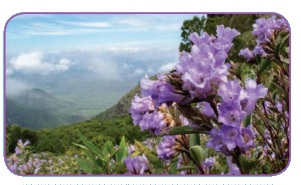
2. Pollination
The
transfer of pollen grains from the anther to stigma of a flower is called
pollination. Pollination is the first important event in the development of
fruit and seed. Pollination is followed by fertilization. Two types of
pollination take place in the flowering plants. They are self pollination and
cross pollination.
The
transfer of pollen grains from the anther of a flower to the stigma of the same
flower is called self pollination. The transfer of pollen grains of a flower to
the stigma of another flower of a different plant of the same species is called
cross pollination.

In
self pollination, seeds produce weak plants and new varities of plants cannot
be produced. In cross pollination, seeds produce good plants and new verities
of plants can be produced. Pollination takes place through different agents.
They are explained below.
* Pollination by Wind (Anemophily)
The
flowers pollinated by wind are mostly small in size and do not have any
attractive colour, smell and nectar. The pollen grains are non-sticky, dry,
light and powdery. Hence, they are easily carried by the wind. E.g. Grass,
Maize, Pine.
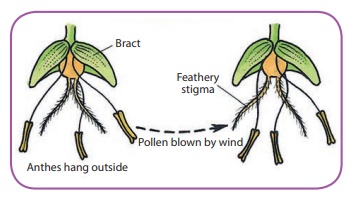
* Pollination by Water (Hydrophily)
The flowers of water plants are not
colourful and they have no nectar. Pollen grains of these plants have
mucilaginous covering to protect them from getting wet. They float in water and
reach the other plant. E.g. Vallisneria, Hydrilla, Zosteria.
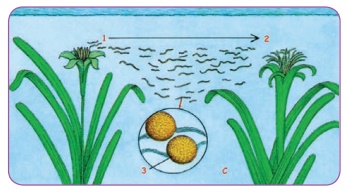
* Pollination by Insects (Entamophily)
This is the most common type of
pollination in plants like sunflower, ladies finger, brinjal and pumpkin. Some
flowers are large in size and they have sweet smell. Some of these flowers
produce nectar. They attact insects like butterflies and honey bees.
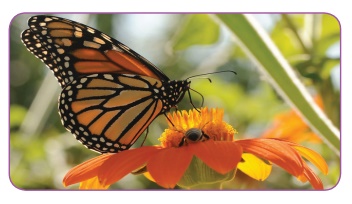
Do you know?
Fruit bats, humming birds
and ants may also act as pollinating agents. Pollination by birds is known as
Ornithophily.

Activity
Classify the plants based
on the pollination methods.
Vallisneria, Hydrilla, Sunflower, Grass, Brinjal, Maize, Pumpkin.

3. Fertilization
The process of fusion of male (pollen
grains) and female (stigma) gametes is called fertilization. The cell which
results after fusion of the gametes is called a zygote. The zygote develops
into an embryo.
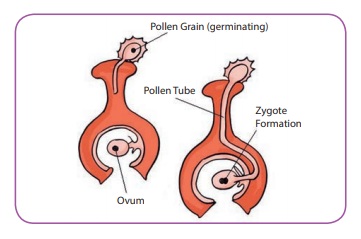
4. Fruits and Seed formation
After fertilization, the ovary grows
into a fruit and other parts of the flower fall off. The seeds develop from
the ovules. The seed contains an embryo enclosed in a protective seed coat.
Based on the number of cotyledons in the seed, the angiosperm plants
have been divided into two groups namely, dicotyledon and monocotyledon.
Activity 3
Collect seeds of different
plants from your area. Find out whether they are monocotyledons or dicotyledons.
Dicotyledons have seeds with two
cotyledons. E.g. Pea, Bean, Castor. They have leaves with netted venation and
taproot system.
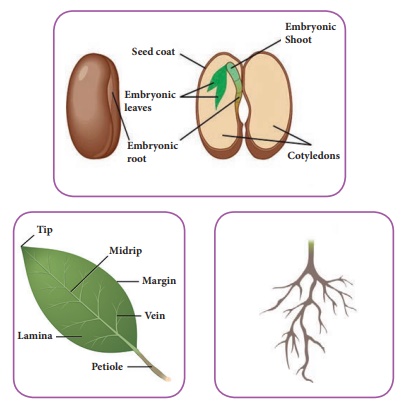
Mono
cotyledons have seeds with one cotyledon. E.g. Maize, Rice, Wheat. They have
leaves with parallel venation and fibrous root system.

II. Life Cycle of a Flowering Plant
The major stages of the flowering plants
are the germination of seed, growth, flowering, re-production (pollination),
seed formation and seed spreading. Every seed has minute plant called the
embryo. Under favourable conditions like sunlight, water and soil, embryo is
grown up into a new plant. This new plant bears fruits with seeds and
multiplies. This cycle continues forming the life cycle of flowering plants.
1. Dispersal of Seeds
Spreading of seeds from one place to
another with the help of agents like air, water, animals and birds is known as
dispersal of seeds. A single plant produces a large number of seeds. If all
these seeds fall directly below the parent plant, the seedlings would have to
compete for space, water, oxygen, minerals and sun light. When the seedlings
are grouped together in one place, they can easily be destroyed by grazing
animals. But, by nature the seedsand fruits of plants are distributed far and
wide through various agencies.
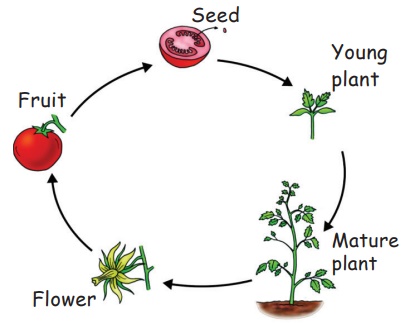
* Dispersal by Wind (Anemochory)
The seeds which are smaller, lighter and
tiny float in air over long distance. Some of them proceed with hairs and
membranous wing like structures and so they are carried away easily. E.g. Cotton
seed, Drumstick.
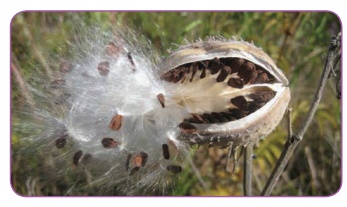
* Dispersal by Water (Hydrochory)
Fruits which are dispersed by water have
outer coats modified to enable them to float. The mesocarp (middle layer) of
coconut is fibrous and is easily carried away by water. They reach different
places and grow into a new plant. E.g. Lotus, Coconut.

* Dispersal by Animals (Zoochory)
Some
fruits have hooks, spines, bristles, stiff hair etc, on their outer coat. These
fruits stick on the furry coats or skins of some animals and are carried from
one place to another. E.g. Xanthium, Achyranthus.
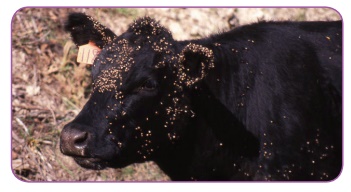
* Dispersal by Birds
While
eating fruits like tomato and guava, birds eat seeds also along with the edible
portion and they are passed out in the excreta later. These types of seeds are
protected from the digestive juices by their seed coat.

* Self Dispersal Method (Autochory)
Some
fruits disperse their seeds in the wind through an explosive mechanism and
spread them. E.g. Ladies finger, Balsam.
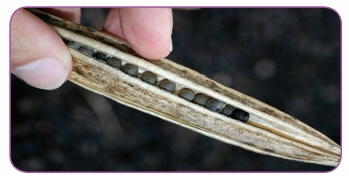
Activity 4
Collect variety of seeds
with hair, wings, hooks and spines. Keep them in a card board box separately.
Name them and collect information on how they are dispersed.
Do you know?
Man is also responsible
for the dispersal of many fruits and seeds. Useful plants like cinchona, rubber
and eucalyptus have been successfully introduced by man, to the new
surroundings far away from their original habitat.
2. Germination of Seeds
The seed is a fertilized ovule. It
consists of embryo, food materials which are protected by the seed coat. During
favourable conditions, the seed germinates and gives rise to a new seedling.
During the early stages of germination, the seedlings get the food required for
its growth from the cotyledons. After the food stored in the cotyledons has
been used up, the seedling gets its food from the soil. The seedling absorbs
water and nutrients from the soil with the help of its roots. It develops
leaves and grows into a plant.
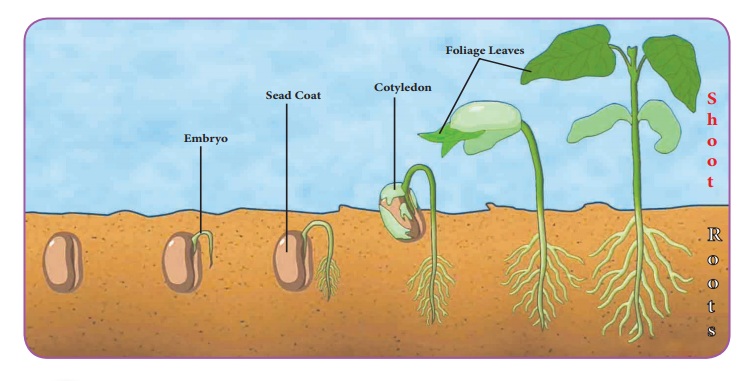
III. Agriculture
Man started practicing agriculture
thousands of years back. This was one of the developments of civilization. In
the modern days agriculture is practiced on a large scale due to the
advancement of science and technology. Application of modern technologies like
plant breeding and usage of chemicals like fertilizers and pesticides have
increased the yield. Major agricultural products are cereals, vegetables,
fruits and oil seeds. They are cultivated not only for our basic needs but also
for commercial purpose.
1. Soil
Soil is one of the most important
natural resources. It is essential for agriculture. It supports the growth of
plants by holding the roots and supplying water and nutrients. It is the home
for many organisms. Soil is formed by the breaking of rocks by the action of
wind, water and climate. The mixture of rock particles and humus is called the
soil. The soil is classified on the basis of the proportion of various sizes.

* Sandy soil
It contains greater proportion of big
particles. They cannot fit closely together. Water can drain quickly through
the spaces between the sand particles. So, sandy soils tend to be light, well
aerated and dry.
* Clay soil
It contains greater proportion of fine
particles, packed tightly together, leaving little space for air. It can retain
a lot of water in the tiny gaps between the particles. Plants like paddy grow
well in this soil.
* Loamy soil
It contains large and fine particles in
almost same proportion. The best top soil for growing plants is loam. It is a
mixture of sand, clay and another type of soil particle known as silt. Silt
occurs as a deposit in river beds. It has right water holding capacity for the
growth of plants. Clay and loamy soil are suitable for growing wheat, gram and
paddy.
Activity 5
Take a little amount of
soil and powder it. Put this soil in a glass tumbler. Mix it with water; stir
it well with a small stick to dissolve the soil. Let it undisturbed for some
time. Now you can see different layers of soil. The rotting matter floating on
the water is called humus. The other layers are clay, sand and gravel. From
this we can see that the soil is a mixture of various particles.
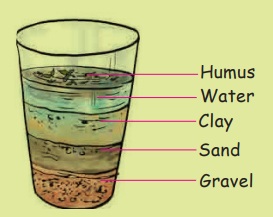
2. Classroom Agriculture
Classroom agriculture creates the basic
understanding about agricultural practices in the classes. Through this, we
come to know about the values and importance of agriculture. To mould us into
better members of the society, this programme teaches the connections between
agriculture and the environment, food, energy, animals, society, economy,
science and technology.
IV. Friends of Farmer
Insects are generally considered to be
harmful. But, many of them are helpful to us in many ways. Earthworm, honeybee
and dragonfly are useful to plants and farmers.
* Earthworm
Earthworms help to increase the amount
of air and water that gets into the soil. They break down organic matters like
leaves and grass into smaller particles that plants can use. When they eat
them, they leave behind castings that are a type of fertilizer. The process of
decomposing bio-degradable wastes by earthworms is known as vermicompost.
Activity 6
Visit a nursery garden
near your area and observe how the varieties of saplings are growing there.
Prepare a report about it.
* Honey bee
Honey bees are helpful for cross
pollination in flowers. They are attracted by the colour and smell of the
flowers. They convert the pollen which is the only natural protein source for
them into honey. Honey is used as food and also for medicinal purposes. Bees
also produce wax, which is used for making candles.
* Dragon fly
It destroys the egg and larva of harmful
insects and mosquitoes and prevents the spreading of diseases. It is also
helpful in cross fertilization.

Related Topics